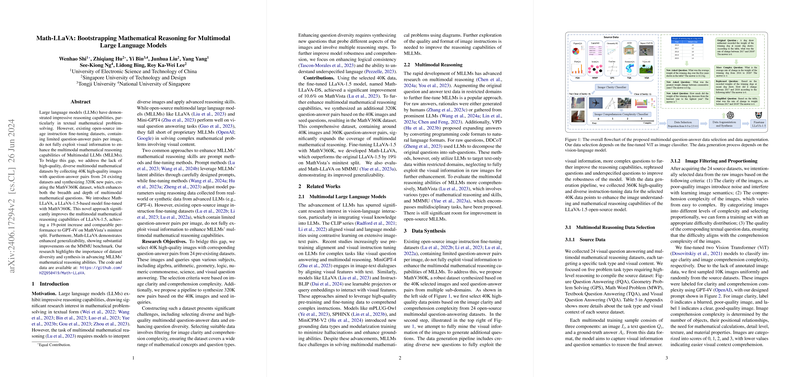The paper "Math-LLaVA: Bootstrapping Mathematical Reasoning for Multimodal LLMs" addresses the challenge of enhancing multimodal mathematical reasoning capabilities in Multimodal LLMs (MLLMs). The authors propose a methodology centered on the development of a robust dataset, called MathV360K, and a fine-tuned model, Math-LLaVA, based on LLaVA-1.5.
Key Contributions:
- Dataset Construction:
- Development of the MathV360K dataset, comprising 40,000 high-quality images with question-answer (QA) pairs aggregated from 24 existing datasets, supplemented by an additional 320,000 synthetic QA pairs. This dataset spans diverse subjects like algebra, geometry, logic, and science, enhancing both breadth and depth in multimodal mathematical queries.
- Emphasis on increasing multimodal question diversity by mining images thoroughly to synthesize new QA pairs. This involves augmenting existing datasets with complex, logically consistent, and rephrased questions.
- Model Development:
- Introduction of Math-LLaVA, a model built on the LLaVA-1.5 architecture, fine-tuned using MathV360K. This model aims to significantly extend the multimodal mathematical reasoning capabilities of its predecessor.
- Application of advanced techniques for data augmentation, ensuring that the newly synthesized dataset does not cause model overfitting but enhances generalizability instead.
- Empirical Results:
- Math-LLaVA demonstrated a 19-point improvement over LLaVA-1.5 on the MathVista benchmark's minitest split, closely challenging the performance of closed-source models like GPT-4V.
- On the MathVista benchmark, Math-LLaVA surpassed other open-source models and systematically outperformed LLaVA-1.5 in different categories, such as Geometry Problem Solving (GPS) and multidisciplinary question answering tasks evaluated on the MMMU benchmark.
- Approach to Data Challenges:
- The authors highlight the critical role of data selection and synthesis, particularly in improving logical consistency and addressing challenges like semantic underspecification in questions. They fine-tuned a Vision Transformer (ViT) model for selecting images based on clarity and comprehension complexity, promoting a training dataset with a balanced difficulty level distribution.
- Future Directions:
- The authors recognize the absence of intermediate problem-solving steps in the dataset, planning to introduce such components to further bolster the MLLMs' capabilities in future research.
Overall, the paper provides an extensive analysis of enhancing LLMs with a focus on mathematical reasoning in a multimodal context, showcasing the efficacy of diverse, well-curated datasets combined with sophisticated fine-tuning. The approach underscores the importance of leveraging diverse and synthesized data to improve reasoning skills beyond mere text processing.
